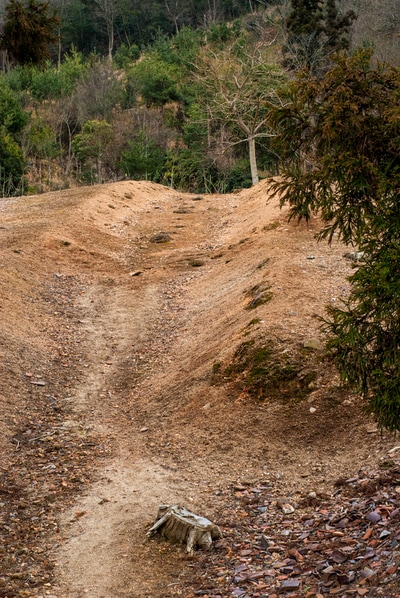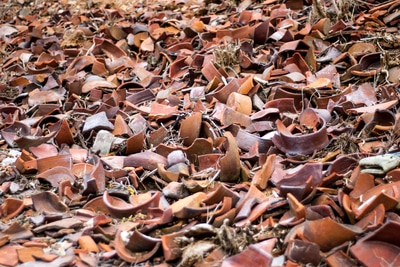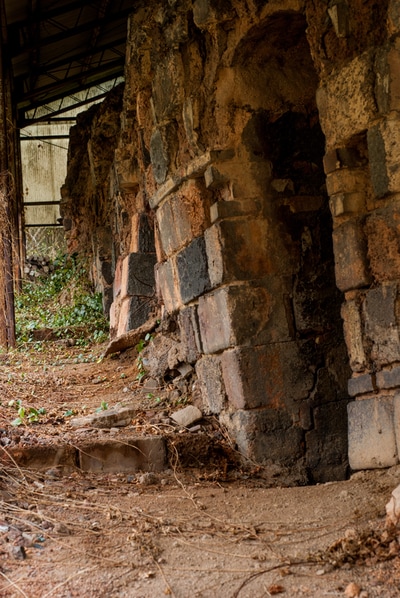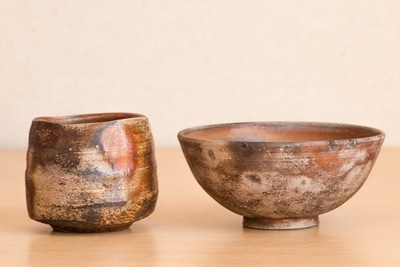| Last month, I finally made it to Bizen in Okayama prefecture where potters have been making pots for centuries, with a peak in popularity during the Muromachi period (1338-1573). During the Edo period (1603-1868), to face the increasing demand, a communal kiln was built on the side of the mountain, south of what is now Inbe station. Today, there are only vestiges of these huge kilns: trenches and piles of pottery fragments. The ground is completely covered with these, whose colours range from deep purple to brick red with white speckles and everything in between. There are spouts, parts of jars, bowls, some with simple patterns... it is a beautiful collection of colours and textures. Unfortunately, when Japan opened to the West in 1868, interest in japanese traditional crafts steadily declined but thanks to Kaneshige Toyo, Bizen’s pottery was preserved and revived after WW2. Bizen-ware is left unglazed but depending on the placement in the kiln, different effects can be obtained. There are 6 different kinds of visual styles: Goma, Sangiri, Botamochi, Hidazuki, Aobizen and Fuseyaki. Of course the results are never certain, since it’s impossible to control the flames perfectly. These six different styles are exhibited at the Bizen Ware Art Museum across from Inbe station. When I went there in February 2017, they had a beautiful collection of pieces from Tadashi Hirakawa on the second floor. His collection of Antipodes and Space-time works caught my eyes with their thick walls and clean shapes. | |
Tadashi Hirakawa has spent years trying to rebuild medieval kilns from Bizen which were not made of fire resistant bricks as it was later, but from a structure covered in soft clay ; hence the name Tsuchigama (clay kiln). It was very interesting to see videos and photos of the kiln he built in Arkansas with Chris Powell.
On the third floor of the museum, pieces by the potters honoured as intangible cultural property and living national treasures are exhibited. One of them, Jun Isezaki became a Living National Treasure back in 2004. Jun Isezaki‘s pieces are very sculptural, an interesting mix between traditional techniques and contemporary art.
The main street in Inbe is lined up with countless galleries, most of them adjacent to the pottery studio. Going from gallery to gallery, hearing about the family stories was a wonderful experience. At Ichiyougama, the owner agreed to show us the Noborigama (climbing kiln) in the backyard. They fill it with thousands of pieces and fire it about twice a year. Going inside the kiln, we could see how the chambers were connected and how the air could flow from one to another.
Bizen ware has gorgeous colours and textures, one single piece has so much to offer to the eye. The shapes can be smooth and very refined but also very rough. I loved looking at these, imagining the swift and expert movement that shaped the clay. These pieces feel alive, like they have a story to tell. I brought back home a couple of pieces, one is a bowl by Yasushi Mori with beautiful colours and the other one is a gorgeous cup by Nobuyoshi Shibaoka . There is something very special about using such stunning pieces everyday.
On the third floor of the museum, pieces by the potters honoured as intangible cultural property and living national treasures are exhibited. One of them, Jun Isezaki became a Living National Treasure back in 2004. Jun Isezaki‘s pieces are very sculptural, an interesting mix between traditional techniques and contemporary art.
The main street in Inbe is lined up with countless galleries, most of them adjacent to the pottery studio. Going from gallery to gallery, hearing about the family stories was a wonderful experience. At Ichiyougama, the owner agreed to show us the Noborigama (climbing kiln) in the backyard. They fill it with thousands of pieces and fire it about twice a year. Going inside the kiln, we could see how the chambers were connected and how the air could flow from one to another.
Bizen ware has gorgeous colours and textures, one single piece has so much to offer to the eye. The shapes can be smooth and very refined but also very rough. I loved looking at these, imagining the swift and expert movement that shaped the clay. These pieces feel alive, like they have a story to tell. I brought back home a couple of pieces, one is a bowl by Yasushi Mori with beautiful colours and the other one is a gorgeous cup by Nobuyoshi Shibaoka . There is something very special about using such stunning pieces everyday.




